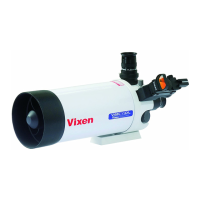Targeting the sky
After I aligned the Skypod and Starbook
with two known stars, it was time to put the
telescope through its paces. Each time,
pointing accuracy was good enough to get
the target in or near the field of the 25mm
eyepiece. After centering each subsequent
object in the view, I found that pressing the
“Align” button further improved the
mount’s pointing accuracy.
The Starbook’s built-in library includes
some 14,000 stars down to 7th magnitude,
all of the Messier objects, nearly 5,000 NGC
and IC objects down to 14th magnitude, as
well as the Sun, Moon, and planets — all
organized into several categories. The
“Famous Object” list sorts deep-sky objects
by their popular names, although it lists the
Crab Nebula (M1) as the “Club Nebula.” I
expect Vixen’s next update to correct this.
In actual use, the Starbook’s LCD backlit
display worked well until temperatures
dropped below freezing. Strapping a hand-
warmer to the back of the case with a rub-
Vixen Optics
1010 Calle Cordillera
Suite 106
San Clemente, CA 92673
[t] 949.429.6363
[w] www.vixenoptics.com
contact information
tHE Vmc110L modified-Cassegrain tele-
scope attaches to the Skypod mount with
Vixen’s dovetail assembly. This standard-
ized connection functions throughout
Vixen’s telescope line.
ber band, however, helped restore the
image. The motors inside the Skypod also
performed sluggishly at temperatures below
about 20° F (–7° C).
Speaking of power, the mount cannot be
used in manual mode. So it’s best to bring
along an extra set of batteries just in case.
Better still, plug the Skypod into a 12-volt
rechargeable car battery jump-starter.
With the Starbook and Skypod both
operational, it was time to put the
VMC110L through its paces. I began star
testing the telescope at 205x using a 5mm
eyepiece. In a perfect scope, out-of-focus
should appear perfectly round and identical
on both sides of focus. Defocusing star
images through the scope revealed circular,
but disparate, patterns indicative of spheri-
cal aberration. As magnification increased,
the impact spherical aberration had on
image quality became more apparent.
I was pleased with what I saw every time
through the supplied 25mm Plössl eyepiece
(which yielded 41x), whether it was the
Orion Nebula, any of winter’s bright open
star clusters, or the Moon.
Focusing was smooth with little image
shift, but images began to soften when I
switched to a 10mm eyepiece (102x).
Although I could see the Cassini Division
in Saturn’s rings, for instance, it was not as
sharp as in my own 4-inch Vixen refractor
with the same eyepiece.
The bottom line
Vixen’s Skypod is an innovative design that
takes grab-and-go astronomy to a new
level, thanks to the Starbook. Although a
couple of ergonomic issues exist, the Star-
book includes more than enough target
objects to entertain its owner for years. And
the compact VMC110L catadioptric tele-
scope performs fine as long as you don’t
push its magnification beyond about 100x.
Together, they make a great travel team if
you’re jetting off to a dark location and
want to keep everything together in a sin-
gle, neat package.

